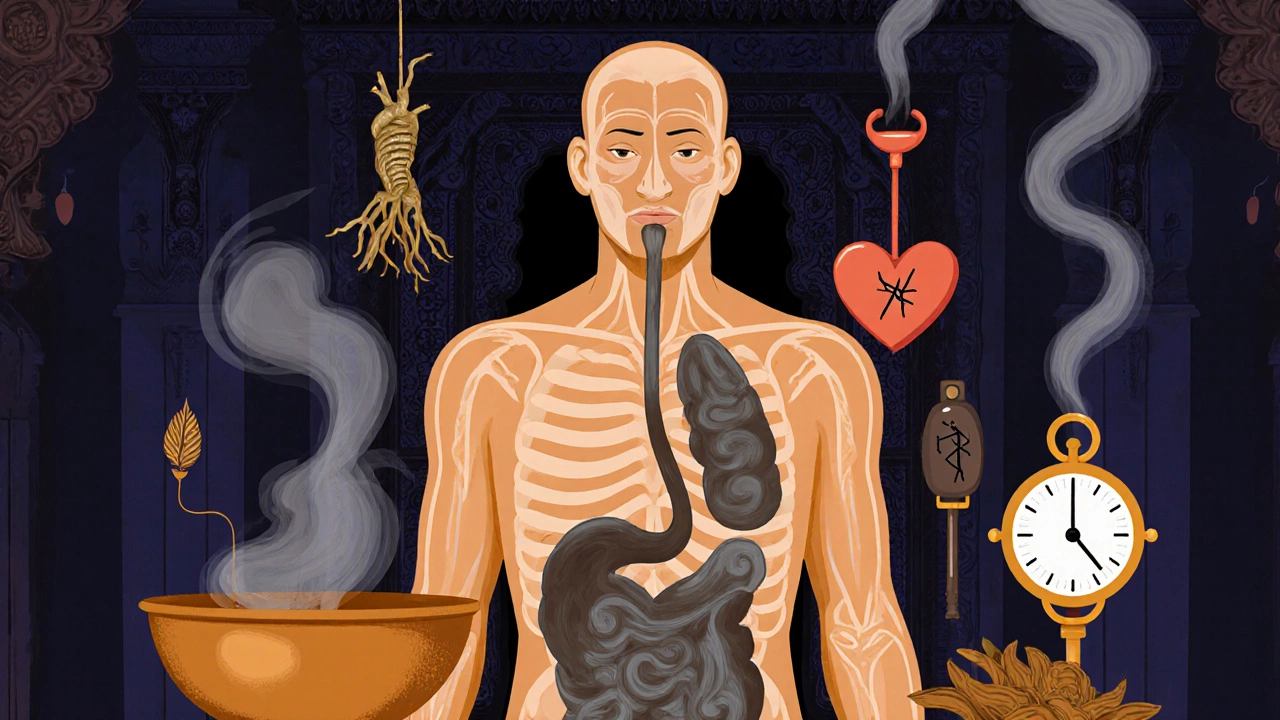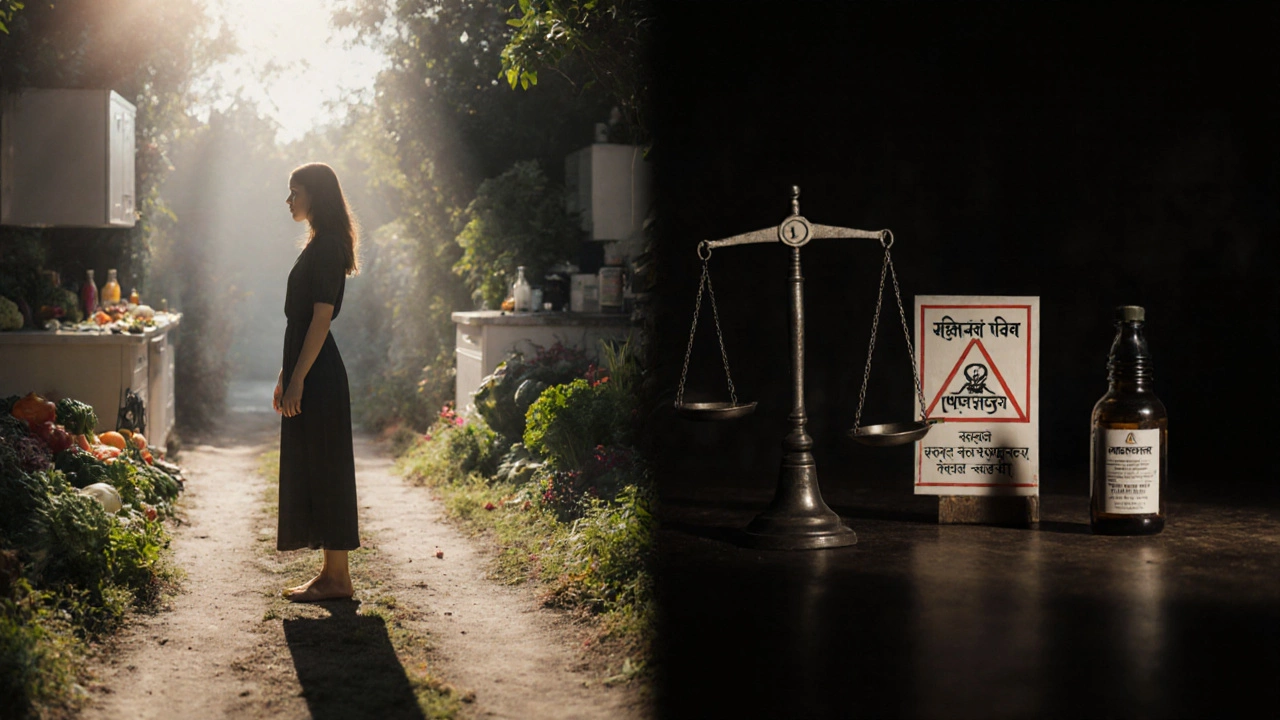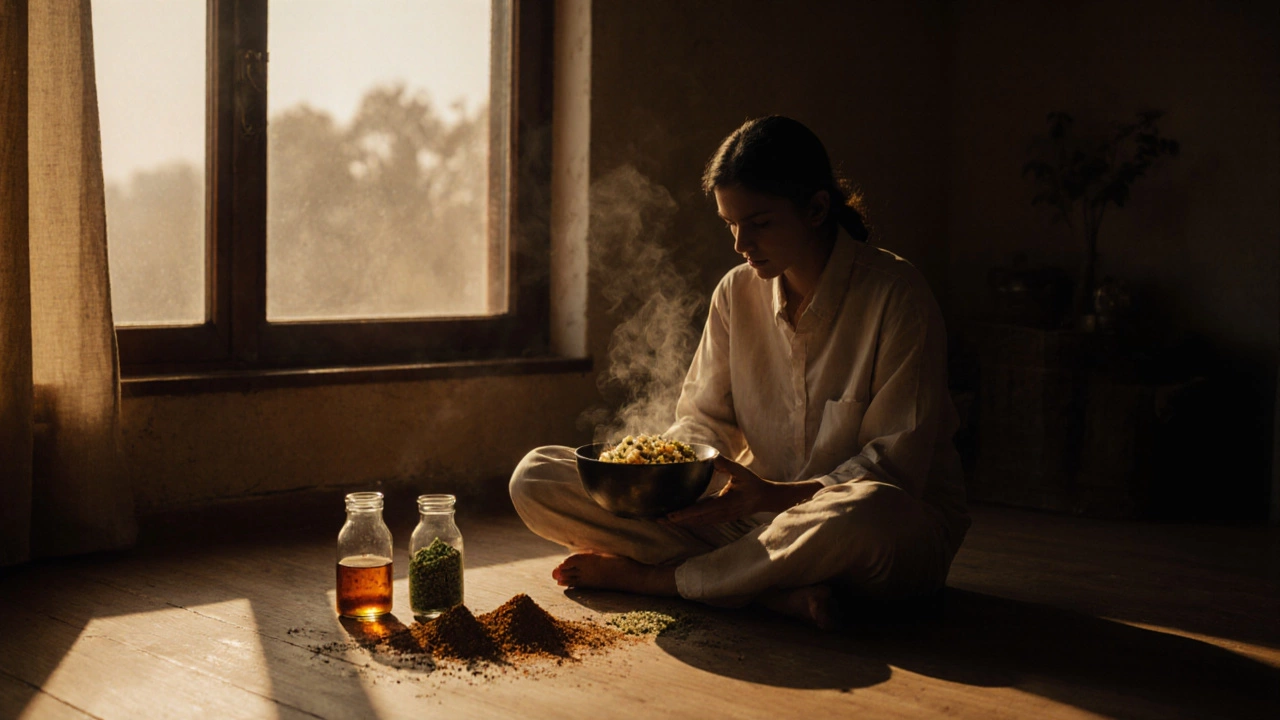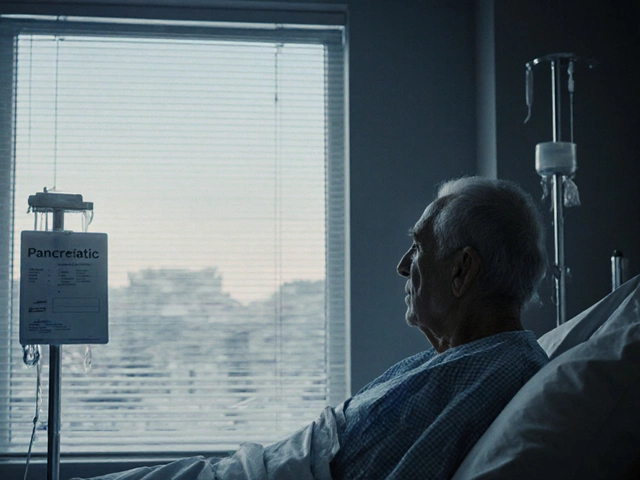Ayurvedic Cleanse Safety Checker
This tool helps you determine if an Ayurvedic cleanse is safe for you based on your health conditions and medications. It's important to understand that some "natural" treatments can have serious side effects.
Your Risk Assessment
Many people turn to Ayurvedic cleanse hoping to reset their digestion, lose weight, or feel more energized. But what happens when your body reacts to these powerful herbal formulas and fasting protocols? The truth is, Ayurvedic cleanse isn’t always gentle-even if it’s called ‘natural.’ While it’s been used for thousands of years, modern bodies, modern diets, and modern health conditions mean the old rules don’t always apply.
What Is an Ayurvedic Cleanse, Really?
An Ayurvedic cleanse, often called Panchakarma, is a five-step detox system rooted in ancient Indian medicine. It’s not just drinking herbal tea for a week. It typically includes oil massages (abhyanga), steam therapy (swedana), therapeutic vomiting (vamana), purgation (virechana), and enemas (basti). These are designed to pull toxins (ama) out of deep tissues and flush them from the body.
Most modern versions simplify this. People start with a liquid diet of kitchari (rice and lentils), drink warm water with ginger or triphala, take herbal powders like neem or guggulu, and avoid sugar, caffeine, and dairy. Some do this for 3 days. Others go for 21 days.
But here’s the catch: these herbs and fasting methods are strong. They don’t just ‘cleanse’-they trigger physiological changes. And when your body isn’t ready, side effects follow.
Common Side Effects You Might Not Expect
Let’s be clear: some discomfort is normal. But many mistake side effects for ‘healing reactions.’ That’s dangerous.
- Severe fatigue-Not just feeling tired. People report needing 10 hours of sleep and still feeling drained. This isn’t ‘detox energy’-it’s your liver overwhelmed trying to process herbs like bhumiamla or katuki while your body lacks calories.
- Headaches and dizziness-Often from low blood sugar or dehydration. Ayurvedic cleanses cut out coffee and sugar, but don’t always replace them with enough electrolytes. A 2023 study in the Journal of Ayurveda and Integrative Medicine found 37% of participants reported headaches during the first 72 hours.
- Diarrhea or constipation-Triphala is a mild laxative. But if you’re already prone to IBS, or take thyroid medication, it can spiral. Some people get explosive diarrhea. Others stop pooping for days. Both are signs your gut flora is being disrupted.
- Nausea and vomiting-Not just from vamana. Herbs like bhringraj or neem can irritate the stomach lining, especially on an empty gut. One woman in Delhi stopped her 14-day cleanse after vomiting bile three mornings in a row.
- Herxheimer-like reactions-This is when dying bacteria or toxins release into your bloodstream. You might get feverish, develop rashes, or feel achy. It’s real. But it’s not always a sign the cleanse is working. Sometimes, it’s a sign you’re overdoing it.
Who Should Avoid Ayurvedic Cleanse Altogether?
Not everyone should try this. Some people are at real risk.
- Pregnant or breastfeeding women-Herbs like dashamoola or haritaki can stimulate uterine contractions. There’s no safe dosage proven in clinical trials.
- People with diabetes-Fasting + herbal hypoglycemics like fenugreek or bitter melon can crash blood sugar. One man in Bangalore ended up in the ER after his glucose dropped to 48 mg/dL.
- Those on blood thinners-Herbs like turmeric, ginger, and guggulu can interfere with warfarin or aspirin. A 2024 case report linked a 60-year-old woman’s brain bleed to an Ayurvedic detox combo she took with her daily blood thinner.
- People with kidney or liver disease-Your liver and kidneys are your main detox organs. If they’re already damaged, forcing them to process concentrated herbs can cause acute failure.
- Underweight or eating disorder history-Cleanses often mean eating less than 1,000 calories a day. For someone with a history of anorexia or orthorexia, this can trigger relapse.

Why ‘Natural’ Doesn’t Mean Safe
There’s a myth that because Ayurveda uses plants, it’s harmless. That’s false. Plants contain potent chemicals. Digitalis comes from foxglove. Morphine comes from poppies. Ayurvedic herbs are no different.
A 2021 analysis by the FDA found that 20% of Ayurvedic supplements sold online contained heavy metals-lead, mercury, arsenic. Why? Poor manufacturing. Some herbs grow in polluted soil. Others are ground with metal mortars that flake into the powder.
Even clean herbs can be dangerous in high doses. For example, amla (Indian gooseberry) is antioxidant-rich. But in large amounts, it can cause liver enzyme spikes. Triphala is safe for most-but not if you’re on immunosuppressants. The dose, the duration, and your health status matter more than the label.
How to Do It Safely (If You Still Want To)
If you’re determined to try a cleanse, here’s how to reduce risk:
- Consult an Ayurvedic practitioner-Not a yoga teacher or Instagram influencer. Find someone certified by the National Ayurvedic Medical Association (NAMA) or equivalent. They’ll assess your dosha (body type) and current health before recommending anything.
- Start small-Try a 3-day reset, not 21 days. Skip the enemas and vomiting. Just eat kitchari, drink warm water with cumin, and sleep early.
- Stop if you feel worse-No ‘push through it’ mentality. If you’re dizzy, nauseous, or your heart races, stop. It’s not ‘detoxing.’ It’s your body screaming for help.
- Stay hydrated and eat salt-Add a pinch of Himalayan salt to your water. Electrolytes prevent cramps and dizziness.
- Don’t mix with prescription meds-Tell your doctor what you’re taking. Even ‘natural’ herbs interact. A 2023 study showed 68% of patients didn’t tell their doctors about their Ayurvedic supplements.
What Happens After the Cleanse?
The real test isn’t the cleanse-it’s what you do after.
Many people feel great for the first 2 days. Then they go back to processed food, alcohol, and late nights. The toxins come right back. That’s why Ayurveda says cleansing must be followed by a rebuilding phase-called samsarjana krama. It’s a 5-day gradual reintroduction of foods, starting with rice gruel, then lentils, then vegetables.
Skipping this step is like cleaning your house, then throwing garbage back on the floor. You’ll feel worse than before.

Alternatives That Work Without the Risk
You don’t need a harsh cleanse to feel better. Here’s what actually works:
- Drink warm water with lemon every morning-Gentle, supports digestion, no side effects.
- Eat fiber-rich foods daily-Oats, lentils, vegetables. They naturally bind toxins and move them out.
- Get 7-8 hours of sleep-Your liver detoxifies best while you sleep.
- Reduce sugar and processed oils-This alone reduces inflammation more than any herbal powder.
- Walk 30 minutes a day-Movement helps lymphatic drainage. No herbs needed.
These habits are safer, sustainable, and backed by modern science. You don’t need to purge your body to heal it.
Frequently Asked Questions
Can Ayurvedic cleanse help with weight loss?
Some people lose weight during a cleanse, but it’s mostly water and muscle, not fat. The weight comes back as soon as you eat normally again. Sustainable weight loss comes from balanced meals and regular movement-not fasting or herbal purges.
Are Ayurvedic herbs regulated like pharmaceuticals?
No. In the U.S. and EU, Ayurvedic products are sold as supplements, not medicines. That means they don’t have to prove safety or effectiveness before being sold. Labels may say ‘pure,’ but testing often reveals contamination or incorrect dosages.
How long do side effects last?
Mild symptoms like fatigue or bloating usually fade within 2-3 days after stopping. But if you have severe vomiting, diarrhea, dizziness, or a rash that spreads, seek medical help immediately. These aren’t normal detox symptoms-they’re warning signs.
Can I do an Ayurvedic cleanse while on antidepressants?
Not without supervision. Herbs like ashwagandha, brahmi, and shankhpushpi affect serotonin and GABA levels. Mixing them with SSRIs or SNRIs can cause serotonin syndrome-a dangerous condition with high fever, confusion, and rapid heart rate. Always talk to your psychiatrist first.
Is there scientific proof Ayurvedic cleanse works?
There’s limited evidence. A few small studies show reduced inflammation or improved digestion after Panchakarma. But most lack control groups, are short-term, or funded by Ayurvedic institutions. No major medical body endorses it as a standard treatment. It’s best seen as complementary, not curative.
What to Do Next
If you’re thinking about an Ayurvedic cleanse, pause. Ask yourself: Why do I want to do this? Is it because I feel sluggish? Or because I saw a viral video promising ‘miracle detox’?
Real health isn’t found in a 7-day cleanse. It’s built slowly-with good sleep, real food, movement, and stress management. If you’re tired, eat more protein. If you’re bloated, cut out processed snacks. If you’re anxious, breathe. These aren’t sexy solutions. But they’re the only ones that last.






